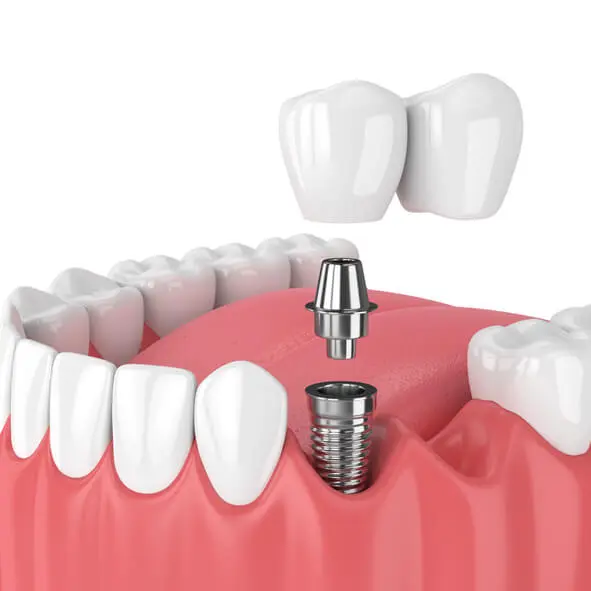Cantilever bridges play a crucial role in both traditional dental prosthodontics and implant dentistry. Unlike conventional dental bridges, which are supported by two abutment teeth or implants on either side of a missing tooth, a cantilever bridge is supported only on one side. This unique design allows it to be an effective solution in specific clinical scenarios, particularly when placing additional abutments is not feasible.
This article explores the intricacies of cantilever bridges on both natural teeth and implants, including their indications, advantages, drawbacks, clinical procedures, and comparisons with conventional bridgework.
Table of Contents
ToggleWhat is a Cantilever Bridge?
A cantilever bridge is a dental prosthesis that extends beyond its supporting structure, relying on a single abutment to support the pontic (replacement tooth). It is a versatile and conservative treatment option, often employed when there is only one adjacent tooth or implant to anchor the restoration.
Types of Cantilever Bridges
Cantilever bridges are classified based on their supporting structures:
- Tooth-Supported Cantilever Bridge – Uses a natural tooth as the sole abutment.
- Implant-Supported Cantilever Bridge – Uses a dental implant as the sole abutment.
Cantilever Bridge on a Natural Tooth
Indications
- Replacement of a single missing tooth when only one adjacent natural tooth is available for support.
- Cases where preparing an additional abutment tooth for a traditional bridge is not desirable.
- Aesthetic restorations in the anterior region where minimal occlusal forces are exerted.
Procedure
- Clinical Evaluation: The dentist assesses the occlusion, bone support, and periodontal health of the abutment tooth.
- Tooth Preparation: The abutment tooth is reshaped to accommodate the bridge.
- Impression and Temporary Restoration: A dental impression is taken for fabrication, and a temporary bridge is placed.
- Laboratory Fabrication: The final bridge is crafted using porcelain, metal, or zirconia.
- Cementation: The final cantilever bridge is cemented onto the prepared abutment tooth.
Advantages
- Requires fewer abutment teeth, preserving adjacent dentition.
- Minimally invasive compared to full-coverage bridges.
- Cost-effective compared to implants or full-arch restorations.
Disadvantages
- Higher risk of overloading the abutment tooth, leading to stress fractures.
- Potential for increased plaque accumulation and periodontal complications.
- Not suitable for posterior teeth subjected to high masticatory forces.
Cantilever Bridge on an Implant
Indications
- Situations where placing a second implant is not feasible due to bone limitations.
- Single missing tooth in a region where esthetic and functional demands can be met with a single implant.
- Patients with financial constraints who prefer a single implant-supported restoration instead of multiple implants.
Procedure
- Diagnostic Planning: Radiographic evaluation and CBCT imaging to assess bone density.
- Implant Placement: A single implant is surgically inserted into the jawbone.
- Healing and Osseointegration: The implant integrates with the surrounding bone over a few months.
- Abutment and Impression: A custom abutment is placed, and an impression is taken.
- Fabrication and Cementation: The final cantilever bridge is fabricated and secured onto the implant.
Advantages
- Eliminates the need for adjacent teeth preparation, preserving natural dentition.
- Provides an esthetic and functional restoration with fewer surgical interventions.
- Effective in cases with limited bone availability.
Disadvantages
- Increased biomechanical stress on the implant due to the lack of additional support.
- Higher risk of implant failure due to excessive occlusal loading.
- Requires careful patient selection and occlusal adjustment to prevent long-term complications.
Comparison: Tooth vs. Implant Cantilever Bridge
| Feature | Tooth-Supported Cantilever | Implant-Supported Cantilever |
|---|---|---|
| Support Structure | Natural tooth | Dental implant |
| Indications | Single missing tooth with one adjacent tooth | Single missing tooth with one implant placement possibility |
| Biomechanical Load | Natural tooth bears the stress | Implant bears the entire load |
| Risk of Failure | Tooth fracture or periodontal issues | Implant overload, screw loosening, or fracture |
| Aesthetic Outcome | May depend on natural tooth color and condition | Controlled, with predictable esthetic outcomes |
| Cost | Lower than implants | Higher due to implant surgery costs |
Long-Term Success and Considerations
The longevity of a cantilever bridge depends on several factors:
- Material Selection: Zirconia and metal-ceramic bridges offer better durability.
- Occlusal Load Management: Proper occlusal adjustments reduce stress on the abutment.
- Patient Oral Hygiene: Good oral hygiene practices prevent plaque accumulation and peri-implantitis.
- Regular Follow-ups: Routine check-ups ensure long-term success by detecting early signs of failure.
Frequently Asked Questions
How long does a cantilever bridge last?
A well-maintained cantilever bridge can last 10-15 years or longer, depending on oral hygiene, material selection, and occlusal forces.
Can a cantilever bridge be placed on molars?
Cantilever bridges are generally not recommended for molars due to the high occlusal forces in the posterior region, which can lead to failure.
Is a cantilever bridge better than an implant?
It depends on the case. Implants offer superior stability and longevity, but cantilever bridges can be a more conservative and cost-effective solution in certain situations.
What materials are used for cantilever bridges?
Common materials include metal-ceramic, zirconia, and all-ceramic restorations, each offering different strengths and esthetic properties.
How do I care for a cantilever bridge?
Regular brushing, flossing, professional cleanings, and avoiding excessive bite forces help prolong the lifespan of a cantilever bridge.

